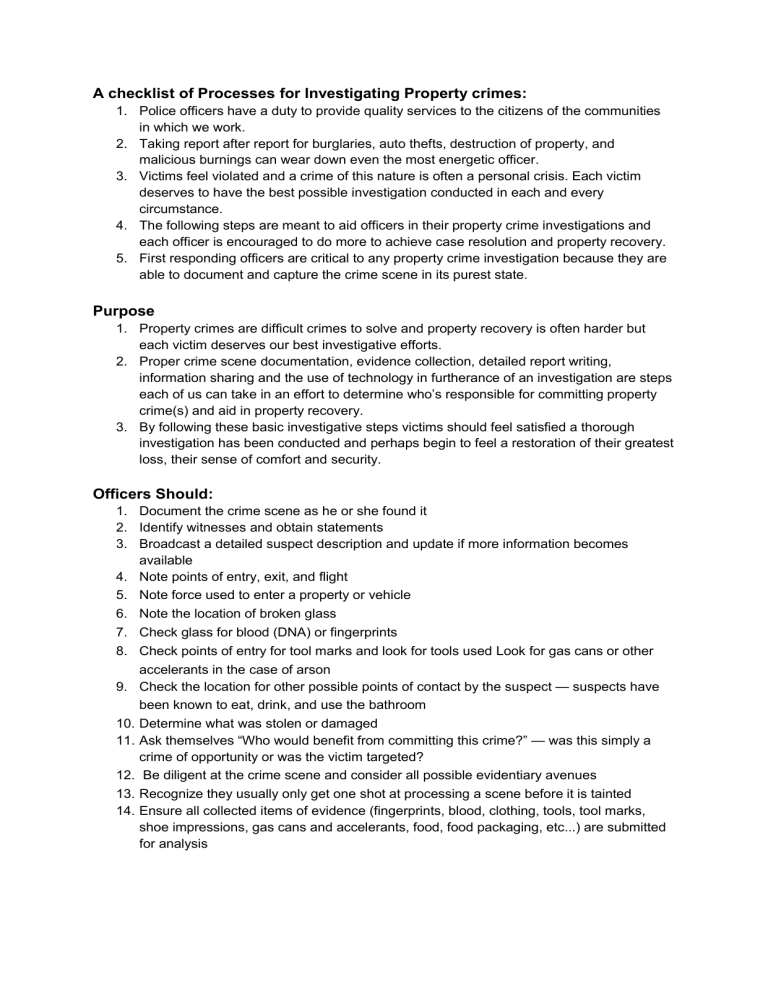
A checklist of Processes for Investigating Property crimes: 1. Police officers have a duty to provide quality services to the citizens of the communities in which we work. 2. Taking report after report for burglaries, auto thefts, destruction of property, and malicious burnings can wear down even the most energetic officer. 3. Victims feel violated and a crime of this nature is often a personal crisis. Each victim deserves to have the best possible investigation conducted in each and every circumstance. 4. The following steps are meant to aid officers in their property crime investigations and each officer is encouraged to do more to achieve case resolution and property recovery. 5. First responding officers are critical to any property crime investigation because they are able to document and capture the crime scene in its purest state. Purpose 1. Property crimes are difficult crimes to solve and property recovery is often harder but each victim deserves our best investigative efforts. 2. Proper crime scene documentation, evidence collection, detailed report writing, information sharing and the use of technology in furtherance of an investigation are steps each of us can take in an effort to determine who’s responsible for committing property crime(s) and aid in property recovery. 3. By following these basic investigative steps victims should feel satisfied a thorough investigation has been conducted and perhaps begin to feel a restoration of their greatest loss, their sense of comfort and security. Officers Should: 1. Document the crime scene as he or she found it 2. Identify witnesses and obtain statements 3. Broadcast a detailed suspect description and update if more information becomes available 4. Note points of entry, exit, and flight 5. Note force used to enter a property or vehicle 6. Note the location of broken glass 7. Check glass for blood (DNA) or fingerprints 8. Check points of entry for tool marks and look for tools used Look for gas cans or other accelerants in the case of arson 9. Check the location for other possible points of contact by the suspect — suspects have been known to eat, drink, and use the bathroom 10. Determine what was stolen or damaged 11. Ask themselves “Who would benefit from committing this crime?” — was this simply a crime of opportunity or was the victim targeted? 12. Be diligent at the crime scene and consider all possible evidentiary avenues 13. Recognize they usually only get one shot at processing a scene before it is tainted 14. Ensure all collected items of evidence (fingerprints, blood, clothing, tools, tool marks, shoe impressions, gas cans and accelerants, food, food packaging, etc...) are submitted for analysis Obtain a Very Detailed List of Stolen or Destroyed Property 1. A detailed description of the stolen/destroyed property or vehicle is key to bolstering the possibility of property or damage recovery 2. Prioritize serialized property or property with unique markings or descriptors 3. Place all stolen serialized property into list 4. Be particularly detailed when describing non-serialized property — include defects and unique identifiers if any are known 5. Try and obtain photos of stolen property or vehicles 6. Share all the information at roll call for at least three days (this way, officers who have been off for a couple of days can learn of the crime, and it will remain fresh in the mind of working officers so they remain on the lookout or you find another officer may have responded to a similar call for service) Consider Other Investigative Avenues to Identify the Suspect 1. MO — was this crime similar to any others within geographical proximity 2. Check other reports and field interviews for suspicious subjects/vehicles, disturbances, neighbour complaints, etc 3. Check local pawn shops and computerized pawn shop databases if accessible for stolen property or possible suspect info 4. Conduct a neighbourhood canvass for possible witnesses or unreported incidents 5. Check with known reliable informants 6. Check impound lots and vehicle “chop shops” 7. Check the location for surveillance video equipment 8. Share all gathered information with specialized investigative units for follow-up Debrief All Arrestees Charged in Unrelated Offenses about Known Criminal Information 1. A valuable investigative tool for gathering intelligence on property crimes or any other type of crime for that matter 2. After processing your arrestees and post-Miranda questioning about the crime leading to their arrest, ask them about their knowledge of other crimes in the area—remember to be specific and ask open ended questions and not those that invite “yes” or “no” responses 3. For example, instead of asking: “Do you know anyone committing crimes in the area?” you can ask: “Who do you know that is breaking into homes or businesses?” 4. You may have several arrestees who tell you nothing but eventually, with persistence, you will find the one who provides a wealth of information and clears several cases for you Consider the Application of Technology to your Investigations 1. Electronic items are becoming more sophisticated and technology is worthy of consideration in your investigations 2. Many new cell phones, laptops, iPads and vehicles have the ability to be tracked via GPS 3. Some manufacturers offer tracking software for their products in the event of theft or misplacement 4. Technology may not only lead to the recovery of property it may also lead you right to the suspect(s)


